In grammar, transition words play a very important role. If used correctly, they can link your ideas, make your paragraphs more coherent, and enhance your writing.
But first – what exactly are transition words and how should you use them?
What exactly are transition words?
Simply put, transition words are words that basically act as the powerful link that holds your sentences together. They are used to show the relationship between two (or more) phrases, sentences, and even paragraphs.
Transition words improve the flow of your writing, and make it more sensible and easier to read. Words like “and,” “additionally,” “because,” “therefore,” etc. are all transition words. Along with transition words, we also have transition phrases like “as well as,” “for example,” “after all,” etc.
Why are transition words used in a sentence?
1. They are link builders
Using transition words helps you connect your ideas and thoughts clearly. It helps the reader understand how different ideas logically are related and not get confused. In addition, these words also prepare the readers for what they should expect next.
Let’s consider the following example:
- Shannon couldn’t sleep well last night. Therefore, she drank two cups of coffee before starting her day.
Now, using the transition word “therefore” helped you achieve two things here:
- It told the reader the cause-and-effect relationship between two things
- It described how these sentences are connected and are a part of one process.
From the above example, the reader will understand that Shannon requires two cups of coffee because she couldn’t sleep well last night. These are two different sentences, but they are glued together with the transition word. Remove the transition word and both of these sentences will lose coherency.
2. Transition words help you put your thoughts in a logical order
Organized thoughts are essential elements of clear and concise writing. Writers should ensure that all the points mentioned in a sentence have a logical flow and there should not be any abrupt pauses between them.
Transition words help in introducing sequence or order to your writing. Here’s how:
Here, we have used two transition words (“first” and “then”) at the beginning of two different sentences. They are used to denote a particular order in which two actions are to be performed.
3. Transition words make your work logical and easy to read
High-quality writing is always clear and easy to understand. It has a logical structure and helps the reader move from one thought to another effortlessly. The simpler the writing, the better the readability!
Transition words are the magic connectors that help you write in clear and plain English.
In both the above-mentioned examples, we have used the transition word at the beginning of the sentences. However, these words can also be used in the middle or at the end of a sense or phrase.
Consider the following sentence, for example:
- I love watching the TV show F.R.I.E.N.D.S because it makes me laugh.
Here, the transition word “because” helps in joining two clauses. It helps the reader understand two things clearly:
- Which TV show does the writer loves watching
- Why do they love watching that particular show
Different categories of transition words
Depending upon their usage and the types of transition a writer wishes to make, transition words are usually divided into multiple categories. There are transition words to show contrast, similarity, examples, and whatnot!
Generally, we have more than one transition word for a particular situation/ transition and so writers can pick the ones according to their liking.
Most of the time, these words mean the same things. However, sometimes they have slightly different meanings. Thus, it is important to understand the meaning and use-case of these words before making your final choice.
Here are some transition word examples according to different categories:
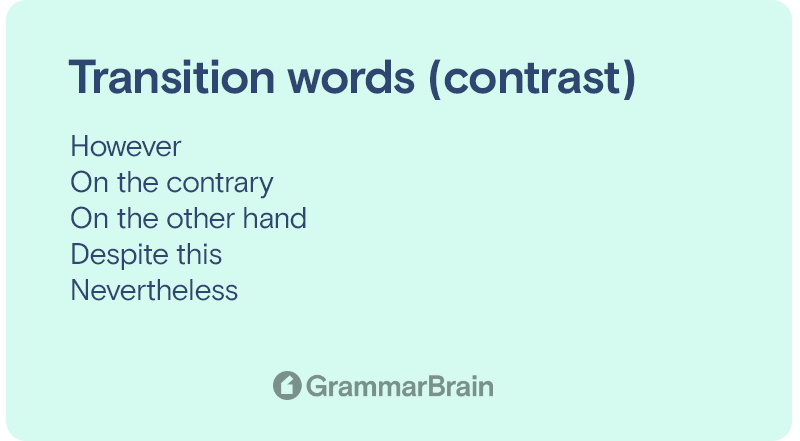
Contrast
When it comes to displaying contrast “but” is the most common transition word. However, it is not the only word. There are several other transition words that you can use to display contrast in your sentences. Some of the common words include:
- However
- On the contrary
- On the other hand
- Despite this
- Nevertheless
More on in contrast transition words.
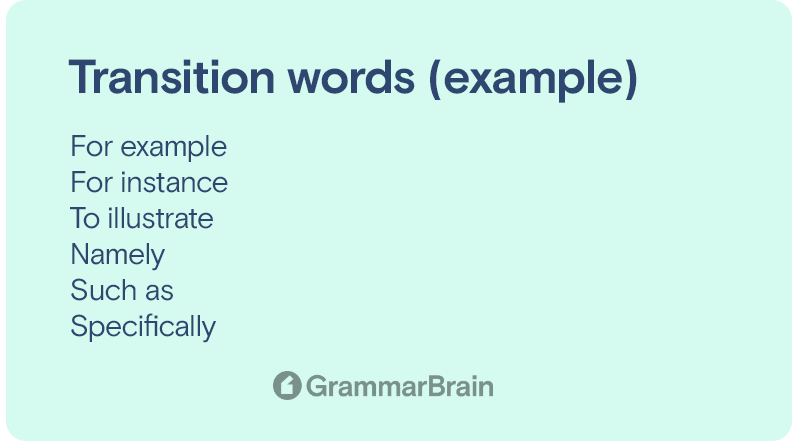
Example
The following transition words should be used for showing examples:
- For example
- For instance
- To illustrate
- Namely
- Such as
- Specifically

Cause and effect
These transition words are used for denoting the cause-and-effect relationship between two sentences. The common transition words you can use for this are as follows:
- Hence
- Therefore
- Thus
- Accordingly
- So
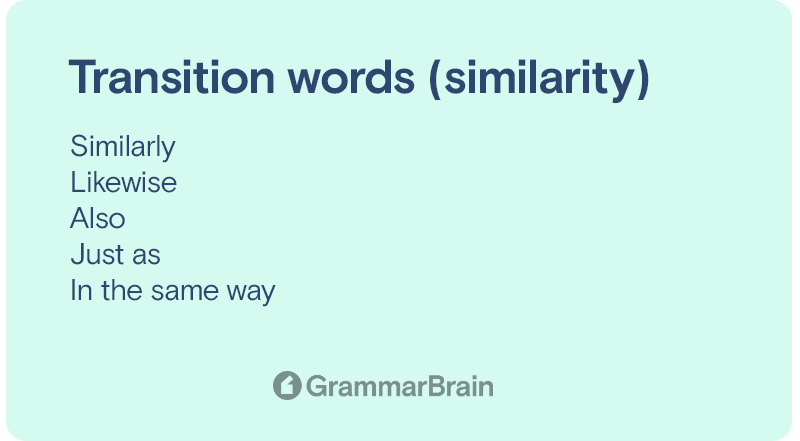
Similarity
Another common use of transition words is to show the similarity between sentences and phrases. Here are some commonly used transition words for denoting the similarity between two sentences:
- Similarly
- Likewise
- Also
- Just as
- In the same way
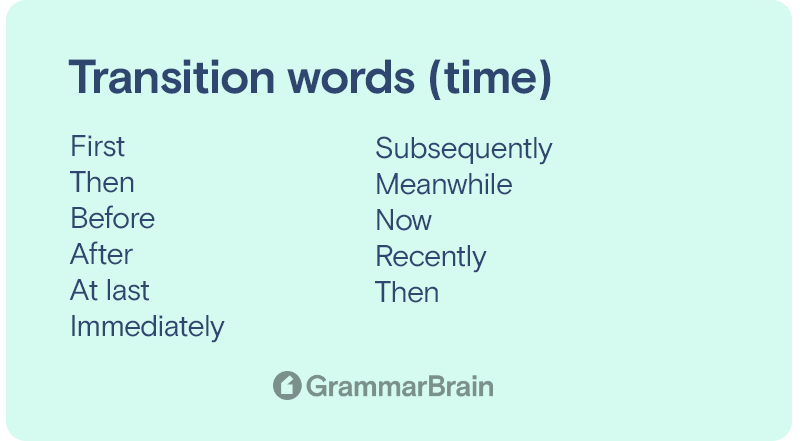
Time
For showing different periods, the following transition words should be used:
- First
- Then
- Before
- After
- At last
- Immediately
- Subsequently
- Meanwhile
- Now
- Recently
- Then
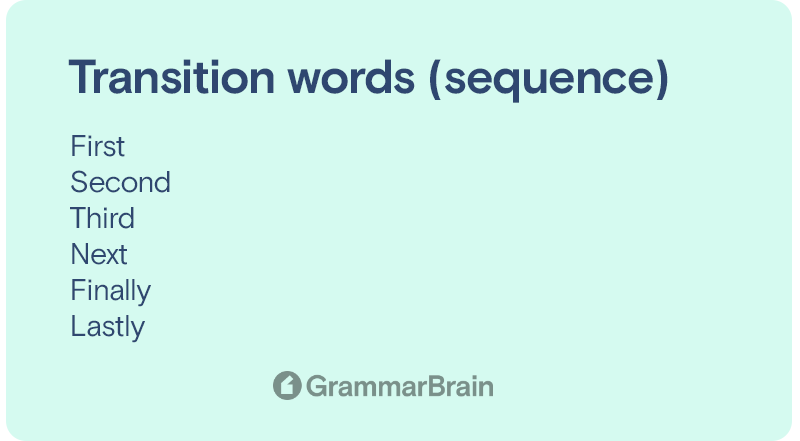
Sequence
These transition words also define sequence or time. Here are some common sequence-based transition words that writers can include in their work:
- First
- Second
- Third
- Next
- Finally
- Lastly
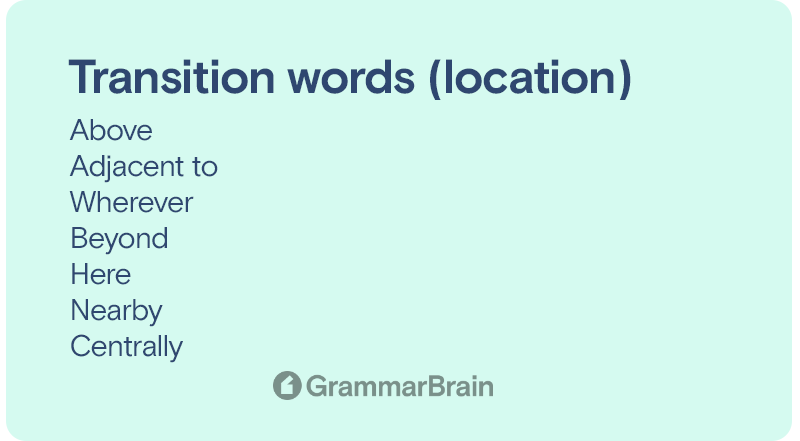
Location
These transition words are used to connect things based on their location or where they are placed to each other. Here are some of them:
- Above
- Adjacent to
- Wherever
- Beyond
- Here
- Nearby
- Centrally
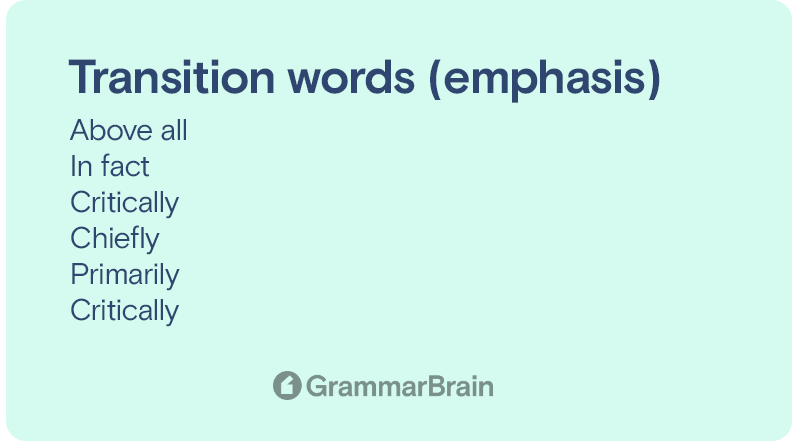
Emphasis
As the name suggests, emphasis transition words help you in stressing an important point and accentuate your argument. Here are some common emphasis transition words:
- Above all
- In fact
- Critically
- Chiefly
- Primarily
- Critically
Conclusion
These transition words offer huge help when you are drafting the conclusion of your work. Whether you are working on a school essay, summing up an idea, or working on your blog, conclusion transition words are an integral part of all kinds of writing.
Here are some common conclusion transition words that writers can use to simplify their writing:
- Thus
- Therefore
- In conclusion
- All in all
- Summing up
- To sum it up
- Ultimately
- In short
- Briefly
- On the whole
More on conclusion transition words.
Do transition words actually make a difference?
The main purpose of transition words is to make clunky, confusing, and disjointed sentences smooth, logical, and coherent. These words must be used to improve the flow of sentences and make your paper more engaging.
When trying to write in plain English, using appropriate transition words wherever possible can make a significant positive impact.
Writers must avoid making abrupt pauses or jumping from one sentence to another illogically. Instead, it is recommended to use transition words to establish an organizational flow in your work.
But the question is – do transition words actually work?
Let’s consider the following sentences – with and without the transition word – and see the difference:
Example 1:
- Jess is going back home for three months. He needs two big bags to carry all his belongings.
While there is nothing wrong with these two sentences, they lack a logical flow. Here’s how using a transition word can improve it.
- Jess is going back home for three months therefore he needs two big bags to carry all his belongings.
Example 2:
- Robin decided to stop studying. She failed high school.
Again, while both of these sentences are grammatically correct, they neither sound good nor logical, There’s an abrupt pause between them. Let’s see how they’ll sound after adding a transition word.
- Robin decided to stop studying. Consequently, she failed high school.
Example 3:
- I could go home. I could stay at the office and finish my work.
Now, these two sentences don’t sound coherent at all. There is something off about them, they lack flow, and they don’t make any logical sense, right? However, once we add a simple transition word between them, they will become so much better. Here’s how:
- I could go home, or I could stay at the office and finish my work.
By adding “or” (a contrast transition word), we linked the sentences. No need to rely on two awkward sentences that are better off as one.
How to use transition words correctly
In order to make a positive difference in your writing, the transition words must be used in a grammatically correct way.
When including transition words in their sentences, writers must remember the following important points:
1. The correct placement: When writing an essay, a blog, or an academic paper, the placement of the transition words plays a crucial role. Writers must plan where they want to place the transition words beforehand and then proceed with writing the sentences.
Generally, transition words can be placed –
- At the beginning of the sentences
- At the end of the sentences
- In the middle of a sentence
2. Use a comma: When using a transition word in the middle of the sentence, it is important to always use a comma (,) before it. Doing so will separate the transition word from the rest of the sentence and give more clarity to your writing.
3. Consider the relationship between two sentences: It is another important tip that every writer must use while including transition words in their writing. Two sentences can have different kinds of relationships. They can be in agreement or disagreement with each other, there can be a cause-and-effect relationship, they can be in chronological order, etc.
Thus, it is crucial to have a clear idea about their relationship before deciding on a transition word.
Key takeaways
In English, using transition words can do wonders for your writing. It can make it more appealing, logical, and clear for the readers. Today, we have learned a lot about transition words and how writers should use them in their work.
Here is a quick summary of everything that we have learned in this article:
- Transition words are words that are used when a writer is transitioning from one point to another.
- They are commonly used as “linking words” that join two or more sentences, phrases, and paragraphs.
- Some common and widely used transition words in English include “also,” “or,” “therefore,” and “thus.”
- There are various categories of transition words and writers can use them depending on the relationship between sentences. Common categories of transition words include – cause-and-effect transition, similarity transition, emphasis transition, contrast transition, and more.
FAQs
1. What are the ten transitional words?
The 10 most commonly used transitional words include the following:
- Also
- Again
- Further
- Furthermore
- However
- Moreover
- Likewise
- Consequently
- Before
- After
2. Can you use two transition words in a sentence?
When using transition words, it is important to strike the correct balance. Overusing transition words can make your work hard to read and reduce its quality.
While you can use multiple transition words in a paragraph, it is recommended to use just one transition word in a sentence.
3. What percentage of sentences should have transition words?
With SEO becoming more and more important, using the right amount of transition words in your content has become all the more important. Following the best SEO practices and including the ideal amount of transition words in blogs and articles can help in increasing their Google ranking.
Ideally, a writer must ensure that at least 30% of their sentences include transition words. This will go a long way in improving the readability of their content and making it more engaging and simple.
4. How do you write an effective transition sentence?
There are several ways to write effective transition sentences. Here are some writing tips that can help writers write effective transition sentences:
- Generally, it is advisable to use transition words at the beginning of your sentences. It helps you introduce the paragraph topic and logically connect the new sentence with the previous one.
- As much as possible, it is advisable to avoid using the transition word “this.” It is because it can make your sentences confusing as it is not always clear what or who “this” refers to. Moreover, many people use pronouns like “this” or “that” as filler words.
5. What are the 5 types of common transitions?
The five most common types of transitions include the following:
- Comparison – For example, “similarly”, “likewise,” “in the same way,” etc.
- Contrast – For example, “on the contrary,” “or,” “otherwise,” “however,” etc.
- Emphasis – For example, “in fact,” “above all,” etc.
- Sequence – For example, “first,” “next,” “eventually,” etc.
- Consequence – For example, “accordingly,” “as a result,” “consequently,” etc.
Sources:
- Wikipedia – Transition
- Yoast SEO – Transition words: why and how to use them
- Your Dictionary – How do I include transition words in my essay
- Writer’s Room – Transition words and phrases
Inside this article
Fact checked:
Content is rigorously reviewed by a team of qualified and experienced fact checkers. Fact checkers review articles for factual accuracy, relevance, and timeliness. Learn more.
Core lessons
Glossary
- Abstract Noun
- Accusative Case
- Anecdote
- Antonym
- Active Sentence
- Adverb
- Adjective
- Allegory
- Alliteration
- Adjective Clause
- Adjective Phrase
- Ampersand
- Anastrophe
- Adverbial Clause
- Appositive Phrase
- Clause
- Compound Adjective
- Complex Sentence
- Compound Words
- Compound Predicate
- Common Noun
- Comparative Adjective
- Comparative and Superlative
- Compound Noun
- Compound Subject
- Compound Sentence
- Copular Verb
- Collective Noun
- Colloquialism
- Conciseness
- Consonance
- Conditional
- Concrete Noun
- Conjunction
- Conjugation
- Conditional Sentence
- Comma Splice
- Correlative Conjunction
- Coordinating Conjunction
- Coordinate Adjective
- Cumulative Adjective
- Dative Case
- Determiner
- Declarative Sentence
- Declarative Statement
- Direct Object Pronoun
- Direct Object
- Diction
- Diphthong
- Dangling Modifier
- Demonstrative Pronoun
- Demonstrative Adjective
- Direct Characterization
- Definite Article
- Doublespeak
- False Dilemma Fallacy
- Future Perfect Progressive
- Future Simple
- Future Perfect Continuous
- Future Perfect
- First Conditional
- Irregular Adjective
- Irregular Verb
- Imperative Sentence
- Indefinite Article
- Intransitive Verb
- Introductory Phrase
- Indefinite Pronoun
- Indirect Characterization
- Interrogative Sentence
- Intensive Pronoun
- Inanimate Object
- Indefinite Tense
- Infinitive Phrase
- Interjection
- Intensifier
- Infinitive
- Indicative Mood
- Participle
- Parallelism
- Prepositional Phrase
- Past Simple Tense
- Past Continuous Tense
- Past Perfect Tense
- Past Progressive Tense
- Present Simple Tense
- Present Perfect Tense
- Personal Pronoun
- Personification
- Persuasive Writing
- Parallel Structure
- Phrasal Verb
- Predicate Adjective
- Predicate Nominative
- Phonetic Language
- Plural Noun
- Punctuation
- Punctuation Marks
- Preposition
- Preposition of Place
- Parts of Speech
- Possessive Adjective
- Possessive Determiner
- Possessive Case
- Possessive Noun
- Proper Adjective
- Proper Noun
- Present Participle
- Prefix
- Predicate



